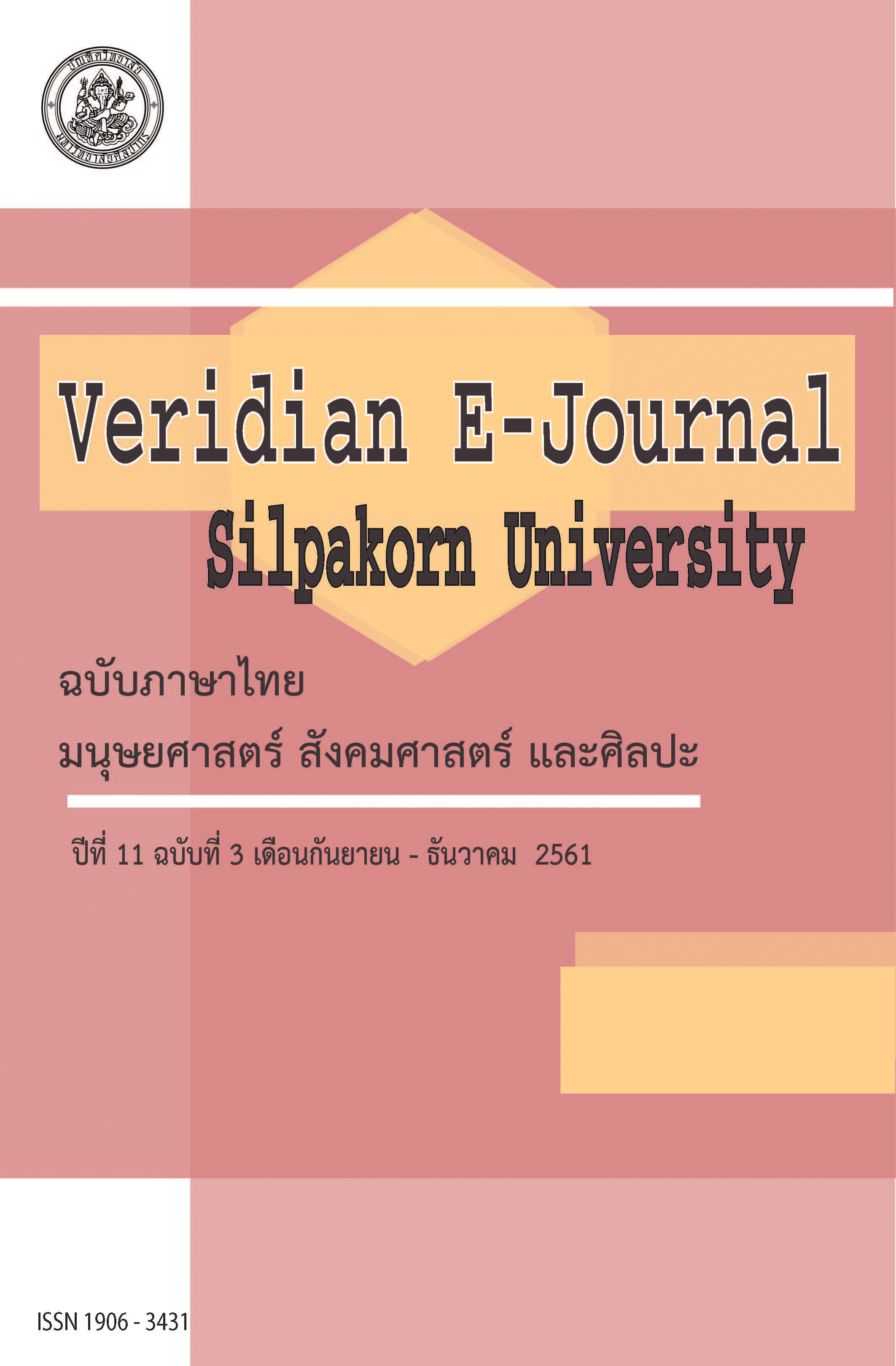อัตลักษณ์ในเพลงเดี่ยวฆ้องวงใหญ่ ทางหลวงบำรุงจิตรเจริญ (ธูป สาตนวิลัย) (The Characteristics in Luang Bamrung Chitcharoen [Thoop Sattanawilai]’s Khong Wong Yai solo)
Main Article Content
บทคัดย่อ
การวิจัยครั้งนี้ มีวัตถุประสงค์เพื่อศึกษาประวัติความเป็นมาของเพลงเดี่ยวฆ้องวงใหญ่ วิเคราะห์เปรียบเทียบทำนองหลักกับเพลงเดี่ยวฆ้องวงใหญ่ รวมทั้งศึกษาอัตลักษณ์ที่ปรากฏในเพลงเดี่ยวฆ้องวงใหญ่ ทางหลวงบำรุงจิตรเจริญ (ธูป สาตนวิลัย) ใช้ระเบียบวิธีวิจัยเชิงคุณภาพ โดยศึกษาข้อมูลเอกสารและการสัมภาษณ์ผู้เชี่ยวชาญ แล้วบันทึกเป็นโน้ตเพลงไทย เพื่อทำการวิเคราะห์ตามหลักวิชาทางดุริยางคศิลป์ไทย
ผลการวิจัย พบว่า หลวงบำรุงจิตรเจริญ (ธูป สาตนวิลัย) เป็นครูผู้มีชื่อเสียงท่านหนึ่งด้านฆ้องวงใหญ่ในสมัยรัชกาลที่ 6 ภายหลังเกษียณอายุราชการจากกรมพิณพาทย์หลวง กรมมหรสพ จึงได้รับเชิญให้เป็นครูในโรงเรียนนาฏศิลป์ช่วงพ.ศ.2490 – 2501 ท่านจึงได้เริ่มถ่ายทอดเพลงเดี่ยวฆ้องวงใหญ่จำนวน 7 เพลง ได้แก่ เพลงนกขมิ้น สามชั้น เพลงพญาโศก สามชั้น เพลงสารถี สามชั้น เพลงแขกมอญ สามชั้น เพลงลาวแพน เพลงเชิดนอก และเพลงกราวใน สามชั้น ให้กับผู้ช่วยศาสตราจารย์สงบศึก ธรรมวิหาร เพียงท่านเดียว ต่อมาใน
พ.ศ.2524 เมื่อผู้ช่วยศาสตราจารย์สงบศึก ธรรมวิหาร โอนย้ายมาเป็นอาจารย์ในภาควิชาดนตรีศึกษา คณะครุศาสตร์ จุฬาลงกรณ์มหาวิทยาลัย จึงได้เริ่มถ่ายทอดเพลงเดี่ยวฆ้องวงใหญ่ ให้กับนิสิตในภาควิชา โดยมีศิษย์ที่ได้รับการถ่ายทอดเพลงเดี่ยวครบทั้งหมดจำนวน 2 คน คือ นายวันกวี สุดใจ และนายอัศนีย์ เปลี่ยนศรี (ผู้วิจัย)
การวิเคราะห์เปรียบเทียบทำนองหลักกับเพลงเดี่ยวฆ้องวงใหญ่ในการวิจัยครั้งนี้ พิจารณาความเหมาะสมและได้รับการถ่ายทอดจากผู้ช่วยศาสตราจารย์สงบศึก ธรรมวิหาร โดยคัดเลือกเพลงเดี่ยวฆ้องวงใหญ่จำนวน 5 เพลง ได้แก่ เพลงพญาโศก สามชั้นเพลงสารถี สามชั้น เพลงแขกมอญ สามชั้น เพลงลาวแพน และเพลงเชิดนอก พบว่า เพลงเดี่ยวฆ้องวงใหญ่ทั้ง 5 เพลง ส่วนใหญ่ดำเนินจังหวะปกติ (เว้นเพลงเชิดนอกที่มีการ ดำเนินจังหวะสลับกันระหว่างการลอยจังหวะและจังหวะนับ) และใช้บันไดเสียงเช่นเดียวกับทำนองหลัก ดำเนินทำนองทางเดี่ยวโดยยึดทำนองหลักเป็นสำคัญ มีทำนองโดดเด่นเฉพาะในแต่ละเพลง โดยเพลงสารถี สามชั้น บางทำนองทางเดี่ยวมีสำเนียงภาษามอญ ส่วนเพลงแขกมอญ สามชั้น บางทำนองทางเดี่ยวมีสำเนียงภาษาแขก และภาษามอญ นอกจากนี้ เพลงเดี่ยวฆ้องวงใหญ่ประเภทปรบไก่ คือ เพลงพญาโศก สามชั้น เพลงสารถี สามชั้น และเพลงแขกมอญ สามชั้น เที่ยวแรกจะดำเนินทำนองทางหวาน เที่ยวกลับดำเนินทำนองทางเก็บ ทั้งยังใช้กลวิธีพิเศษมากที่สุด 3 อันดับแรกคือ การตีเฉี่ยว การตีสะบัดขึ้น การตีไขว้มือ ตามลำดับในเพลงเดี่ยวฆ้องวงใหญ่ทั้ง 3 เพลงข้างต้น ส่วนเพลงลาวแพนใช้การตีเฉี่ยว การตีสะบัดขึ้น การตีกระทบคู่สาม และเพลงเชิดนอก ใช้การตีเฉี่ยว การตีกรอย้อยจังหวะ การตีไขว้มือ มากที่สุดตามลำดับ
อัตลักษณ์ในเพลงเดี่ยวฆ้องวงใหญ่ ทางหลวงบำรุงจิตรเจริญ (ธูป สาตนวิลัย) มี 3 ด้าน ได้แก่ 1) ด้านการดำเนินจังหวะที่ใช้การลักจังหวะหรือย้อยจังหวะ 2) ด้านการดำเนินทำนองทางเดี่ยวที่มีเสียงลูกตกไม่ตรงกับเสียงลูกตกของทำนองหลัก และ 3) ด้านกลวิธีพิเศษที่มีความโดดเด่นมากที่สุดคือ การใช้มือละเอียดที่มีความคล้ายกับการดำเนินกลอนของฆ้องวงเล็ก ด้วยใช้กลวิธีพิเศษ 3 แบบ คือ การตีเก็บ การจบทำนองด้วยการตีกระทบคู่แปด (มือขวา) และการตีขยี้แบบตีกระทบ (เฉพาะเพลงเดี่ยวประเภทปรบไก่)
เพลงเดี่ยวฆ้องวงใหญ่ ทางหลวงบำรุงจิตรเจริญ (ธูป สาตนวิลัย) สะท้อนความเป็นเอตทัคคะด้าน
ฆ้องวงใหญ่ แสดงถึงความไพเราะในเพลงเดี่ยวของท่านได้อย่างสมบูรณ์ จึงเป็นผลงานอันทรงคุณค่าด้านดุริยางค์ศิลป์ไทย และเป็นมรดกทางวัฒนธรรมของชาติให้อนุชนรุ่นหลังได้สืบทอดต่อไป
The objectives of this research on the musical identities of Luang Bumrung Chitcharoen (Thoop Sattanawilai)’s Khong Wong Yai solos are: to study the history and development of Khong Wong Yai solos, to conduct a comparative analysis of the basic melodies of Khong Wong Yai solos and to study the musical identities of Luang Bumrung Chitcharoen (Thoop Sattanawilai)’s Khong Wong Yai solos. Qualitative research methods of documentary research and interviews of music specialists were used. Musical notations of the solo pieces under study were recorded and analyzed according to the traditional Thai music principles.
The research found that Luang Bumrung Chitcharoen (Thoop Sattanawilai) was one of the most skillful and famous Khong Wong Yai masters and teachers in the reign of King Rama VI. After his retirement from the Phin Phat Luang Division in the Mohorasop Department, he became a guest teacher at the School of Dramatic Arts between 1947-1958. It was during this period that he began to pass on his mastery of 7 Khong Wong Yai solos to only one student, Assistant Professor Sa-ngobsuek Dhammawiharn. The said seven solo songs (Phleng) are: Phleng Nok Khamin Sarm Chan, Phleng Phayasok Sarm Chan, Phleng Sarathee Sarm Chan, Phleng Khaek Mon Sarm Chan, Phleng Lao Pan, Phleng Cherd Nok and Phleng Kraow Nai Sarm Chan. When Assistant Professor Sa-ngobsuek Dhammawiharn took up the position of lecturer at the Department of Music Studies, Faculty of Education, Chulalongkorn University in 1981, he began teaching Khong Wong Yai solos to students of the said Department. Two students who were transmitted all seven Khong Wong Yai solos are Mr. Wankawee Sudjai and Mr. Assanee Pleinsri (the researcher).
A comparative analysis of the basic melodies of Khong Wong Yai solos in this research, It considered the suitability and has been relayed solo songs from Assistant Professor Sa-ngobsuek Dhammawiharn. By selected 5 Khong Wong Yai solos, including Phleng Phayasok Sarm Chan, Phleng Sarathee Sarm Chan, Phleng Khaek Mon Sarm Chan, Phleng Lao Pan and Phleng Cherd Nok. The research found that 5 Khong Wong Yai solos mostly in a regular rhythm (Except for Phleng Cherd Nok), alternating between a floating rhythm (Loy Changwa) and a controlled rhythm- Musical scales and the solo melodies are in keeping with the song’s basic melody- Every solo song has a notable melody. Mon melodies are used in certain sections for Phleng Sarathee Sarm Chan and Mon and Khaek melodies are used in certain sections for Phleng Khaek Mon Sarm Chan.
In addition, Prob Kai Khong Wong Yai solo is Phleng Phayasok Sarm Chan, Phleng Sarathee Sarm Chan and Phleng Khaek Mon Sarm which The initial round of performance is played in Thang Warn (mellifluous tune) and the repeated round in Thang Keb (rapid tune) – also used the 3 most techniques rating: Tee chiao, Tee Sabat Khuen, Tee Khwai Mue. Phleng Lao Pan used the 3 most techniques rating: Tee chiao, Tee Sabat Khuen, Tee Krathop Khu Sam and Tee chiao, Tee Kro Yoi Changwa, Tee Khwai Mue are used in the 3 most techniques rating for Phleng Cherd Nok.
There are three dimensions to the musical characteristics of Luang Bumrung Chitcharoen (Thoop Sattanawilai)’s Khong Wong Yai solos: 1) Rhythm – Lak Changwa or Yoi Changwa technique is used; 2) Melody – Look Tok (ending sounds) of a solo differ from the ending sounds of the basic melody; and 3) Special techniques – the most notable special technique used in these solos is the rapid striking movements of the hands similar to the hand movements of Khong Wong Lek verses. Three variations of this special technique are used: Tee Kep, Tee Kratop (with the right hand) and Tee Khayee Baeb Kratop (Only Prob Kai Khong Wong Yai solo) in octaves to end the melody.
Luang Bumrung Chitcharoen (Thoop Sattanawilai)’s Khong Wong Yai solos are perfect testimonies to his unique musical skills and the magnificence of his solo pieces. His works have greatly contributed to the traditional Thai music circle and will remain a valuable cultural heritage for future generations.

